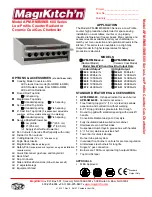
OPERATION
Appliance description
16
| PSH Trend www.stiebel-eltron.com
2.3 Test symbols
See type plate on the appliance.
3. Appliance description
The closed (pressure-tested) appliance heats DHW electrically.
You can adjust the temperature using the temperature selector.
Subject to the power supply, the water is heated automatically to
the required temperature.
The internal steel cylinder is coated with special "Co Pro" enamel
and is equipped with a protective anode. The anode protects the
internal cylinder from corrosion.
Frost protection
The appliance is also protected against frost by the temperature
setting "*", provided that the power supply is guaranteed. The
appliance switches on in good time and heats the water. The ap-
pliance does not protect the water supply lines and the safety
valve from frost.
4. Settings
The temperature can be freely adjusted.
2
1
D
00000
43
64
8
1
ON/OFF indicator
2
Temperature selector
*
Frost protection
E
Recommended energy saving position, low scaling, 60 °C
Max Maximum temperature setting, 80 °C
Depending upon the system, the actual temperatures may vary
from the set value.
ON/OFF indicator
The ON/OFF indicator illuminates when water is being heated.
Temperature indicator
1
3
2
D
00000
5846
0
1 Pointer position at approx. 30 °C
2 Pointer position at approx. 50 °C
3 Pointer position at approx. 80 °C
The current temperature is measured inside the cylinder, at the
position of the temperature indicator (see chapter “Specification /
Dimensions and connections”).
4.1 Holiday and absence
f
If the appliance is not to be used for a few days, set the tem-
perature selector to a position between the frost protection
and energy saving settings.
f
If the appliance is not to be used for a longer period, set it to
frost protection to conserve energy. If there is no risk of frost
you may disconnect the appliance from the power supply.
f
For reasons of hygiene, heat up the content of the water
heater once to above 60 °C before initial use.
5. Cleaning, care and maintenance
f
Have the electrical safety of the appliance and the function of
the safety valve regularly checked by a qualified contractor.
f
Have the protective anode initially checked by a qualified
contractor after the first year. The qualified contractor will
then determine the intervals at which it must be checked
thereafter.
f
Never use abrasive or corrosive cleaning agents. A damp
cloth is sufficient for cleaning the appliance.
Scaling
f
Almost every type of water will deposit lime at high temper-
atures. This settles inside the appliance and affects both the
performance and service life. The heating elements must
therefore be descaled from time to time. A qualified contrac-
tor who knows the local water quality will tell you when the
next service is due.
f
Check the taps/valves regularly. You can remove limescale
deposits at the spouts using commercially available descaling
agents.
f
Regularly activate the safety valve to prevent it from becom-
ing blocked e.g. by limescale deposits.
















































